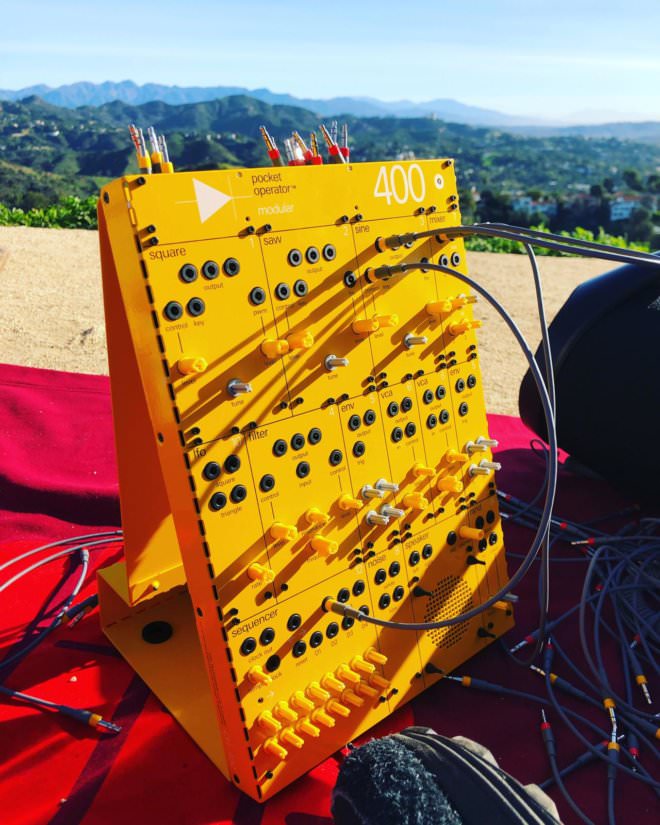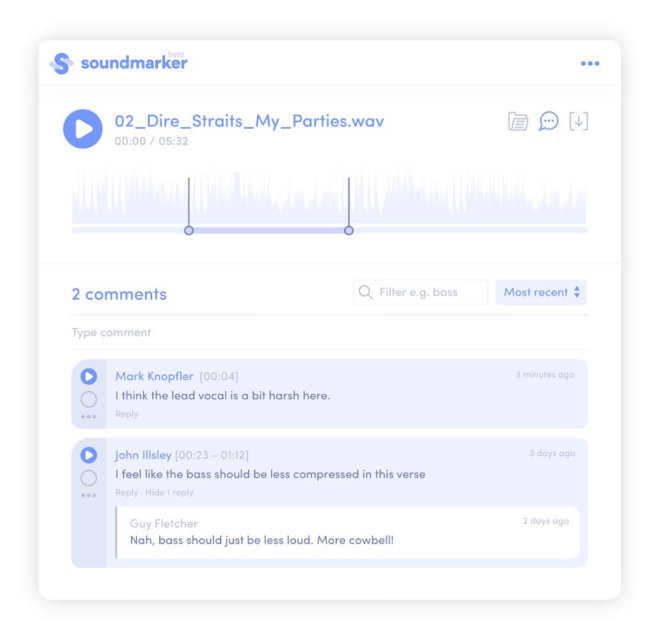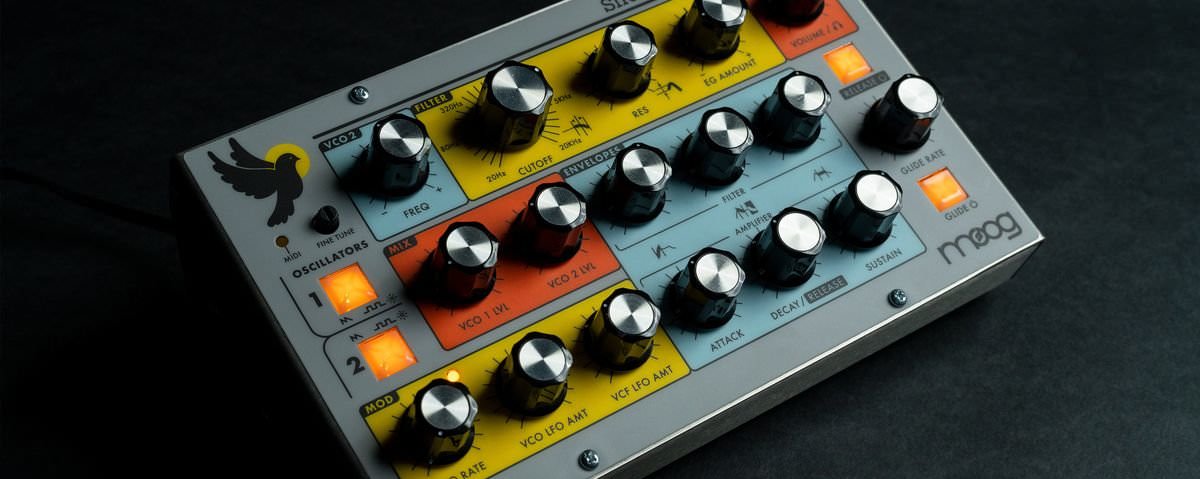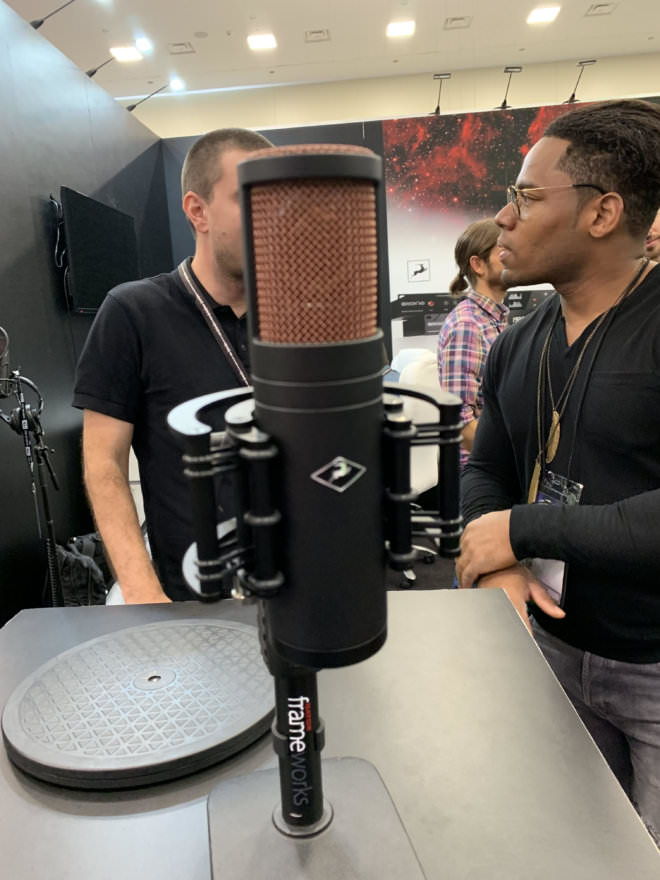Dodging the huddled masses, the slow walkers and the alarming amount of sunset strip rock and roll relics, we braved the floors of NAMM 2019 to bring you our account of this year’s best new releases. Of course, it’s hard to cover everything, but what we did surprised and delighted us. In one case, we even scaled a mountain, which is more exercise than we’ve ever done for content, to get our hands on some new modular designs from Teenage Engineering to tell you about. Let’s get into it…
Moog SirIn – aNALOG MESSENGER OF JOY
It’s hard to pin our favourite release but let’s jump in with a strong contender as Moog announced a limited release of a new bass synth called Sirin. Only 2,500 will be available and, like all limited runs from Moog, they’ll sell out fast.
Sirin resembles the Moog Minitaur in its compact design and adds to Moog’s Taurus line of bass synths. It has two Taurus Bass oscillators and generates notes that are octaves above Moog’s other synth bass offerings. This makes Sirin capable of both melodic leads and classic bass tones. The sound of the synth is shaped by a classic Moog ladder filter that works with two ADSR envelopes and a multi-wave LFO.
Sirin connects directly to a USB midi controller and plays like a standalone analogue synth. Alternatively, Sirin will connect to a computer via USB, where the synth’s dedicated editor software can be used. This software offers deeper, more intensive sound design, comes with 128 presets and controls any parameter.
Komplete Kontrol M32
Native Instruments announced a new addition to the Komplete Kontrol line with the M32 keyboard. Now the smallest, most road-ready Kontrol keyboard, the M32 is perfect for touring musicians or gigging producers moving from studio to studio. It has a 32-key design and is built with similar features, in the same way, as the A and S series controllers.
Like NA’s other Kontrol instruments, M32 seamlessly integrates with any DAW, and the layout is almost identical to the A series keyboards. The only difference being the touchstrips on the M32, instead of the traditional mod wheel, for pitch control and modulation. The onboard OLED screen displays the name of adjusted parameters and a value measure determines the amount. It is fully integrated with all NA instruments and over 750 NKS partner instruments including Arturia, Output, Spitfire, and Softube.
The hub of this NKS integration is the Komplete Kontrol software, which is included with the M32. Additionally, Native Instruments is shipping the keyboard with other NA instruments (Monarch, Prism, Mark One etc), effects (Replica, Phasis), Maschine Essentials, and Ableton Live Lite. It also ships with Komplete Start, a new free software bundle from Native Instruments with over 2000 presets and sounds. All at a $129 US price point, which is pretty incredible.
Teenage Engineering Modular Pocket Operator
Thirty miles north of Anaheim on a ridge in Runyon Canyon, Teenage Engineering unveiled their new line of Modular Pocket Operators. Bucking the status quo with innovation and style, the company adds to a wave of products democratizing modular synthesis with their new line of compact, affordable, assemble-yourself synthesizers. The Modular Pocket Operators come in three different models—16, 170 and 400—all promising high-quality components, smart circuit design and exceptional sound. If you’re going to unveil your move into the world of modular, then why not do it in style on top of a hill in sunny LA.

Teenage Engineering unveiled their Modular 400 at the top of Runyon Canyon. Photo: Lukas Lyrestam
Volcas For Sonic Exploration
Korg unveiled two new Volcas at this year’s NAMM: Volca Drum and Volca Modular. Both Volcas represent a continuation of the line as it moves into new creative directions. Unlike Korg’s other Volca drum modules (Volca Kick, Volca Beats and Volca Sample), Volca Drum is built for sound design. It has a six-part DSP synth engine to create a wide range of drum sounds from two layers of switchable oscillators. It also has a built-in waveguide resonator to add extra grit and is capable of some really interesting sounds.
Volca Modular offers an affordable and understandable way for people to get into modular synthesis. This Buchla-inspired, semi-modular synth has eight modules, built-in digital effects, and a 16-step sequencer. It uses small cables to connect up to 50 patch points and can be patched to outboard gear via CV. Like Volca Drum, it offers endless opportunity for sonic experimentation.
Akai Force
Leading up to NAMM, Akai teased a promotional video that we covered in our Leaks, Rumors and Hype article. The product was Akai Force, a standalone music production studio. Force pays homage to the legendary MPC in its layout and design but exceeds the functionality of a traditional sampler. It has 16GB of internal storage and is capable of sequencing, sampling, synthesis and processing without a computer.
Everything is controlled from the 7-inch, touch-sensitive, full-colour display which captures and recalls the movement of any internal parameter for real-time modulation. It has 64 velocity-sensitive backlit RGB pads, and is perfect for DJ-ing, recording, clip launching and tapping out rhythmic performances.
Soundmarker
Not all exciting announcements at NAMM need to be software plugins or hardware gear. Soundmarker unveiled a really interesting offering to make the lives of producers and engineers a little bit easier.
When you’ve finished a track, you send it to your client, bandmates, friends or a label, right? You expect to get feedback in return. In the best circumstances, that feedback returns from one person in one line of communication. In reality, all the stakeholders (the artist, band members, manager, label etc) communicate in different ways on all imaginable platforms.
Organizing that information is a daunting task for any producer or engineer but Soundmarker, a Dutch start-up, who announced their launch at NAMM, aims to solve this problem.
Soundmarker offers an intuitive web-interface to share streamable audio while organizing creative feedback in one location. Founded by audio engineers who had previously suffered disorganized collaboration, Soundmarker has an incredible set of features including loop-based commenting, lossless downloading and high-res mp3 streaming. Its a game-changer and it’s free, for the time being, for anyone who wants to use it.

Soundmarker offers an intuitive web-interface to share streamable audio while organizing creative feedback in one location. Click to enlarge.
Korg Minilogue XD
Korg improves upon their TEC Award-nominated Minilogue synth with Minilogue XD by adding enhanced features previously available in Korg’s Prologue synth. It’s a polyphonic design that combines the approachability of the Minilogue with professional functionality to reach a new generation of analogue-minded musicians.
XD is thoughtfully designed for performance with a large oscilloscope display, a joystick pitch/mod control, 16-step polyphonic sequencer, stereo outputs, damper pedal and two CV inputs. It adds a digital multi-engine on top of the two analogue oscillators which has three modes and a microtuning function with presets from Aphex Twin. Deepening its sound design, Minilogue XD has a built-in effects engine with modulation, reverb and delay. All can be programmed simultaneously and saved as user presets.
Arturia Microfreak
Microfreak is an algorithmic synthesizer with a versatile digital oscillator and 11 modes. Seven of these modes are designed using an open source code from Mutable Instruments. The internal code, called Plaits, makes rich, balanced sound and powers the Mutable Instruments macro-oscillator that shares its name. Arturia claims the Plaits code puts the power of this Mutable Instruments oscillator unit into the Microfreak synth.
That being said, Microfreak stands on its own, without the Mutable Instruments call out, being chock full of features in a compact design. It has a lush-sounding analogue filter inspired by the Oberheim SEM, which warms any digital signal creating a “best-of-both-worlds” scenario. Like Native Instruments’ Polyplex, Microfreak also has built-in randomization tools for the discovery of happy accidents during your creative process.
Antelope Audio Edge Go
Imagine a large-condenser microphone with an almost flat frequency response. Now imagine that mic has a built-in audio interface and can model the tone, texture and frequency response of the world’s most coveted mics. Such a device would make a relic of the conventional USB mic. And that’s exactly what Antelope Audio is promising with the coming release of Edge Go—the next iteration of their, previously released, Edge modelling microphone. A prototype was on display at NAMM with little buzz or attention, however we expect that buzz to change in the lead up to their late-March release date.
Leapwing Stageone
Leapwing Audio celebrated the release of their Stageone plugin at NAMM this year. Like all of Leapwing’s previous releases, Stageone has a clean, simple design and a singular focus. Its unique algorithm targets the stereo field, enhancing the soundstage of a stereo mix while preserving the mono centre.
Of course, there are many stereo wideners on the market but, from our listening demos, few preserve the quality of a recording while enhancing stereo width quite like Stageone. It can aid with any masking issues in your mix and add rich, wide depth without any unwanted phase. There’s even a mono spread setting to convert mono recordings into pseudo-stereo signals.
make noise QPAS
QPAS from Make Noise stands for Quad Peak Animated System. So, what does that mean exactly?! It’s a quad, stereo and multimode filter – 4 filter cores with resonant peaks each with 4 response types that are simultaneously available – high, low, band and “Smile Pass” which is unique to the QPAS. here’s a “Radiate” control for the animation of the stereo signal. And signals can move from mono-stereo and back again. Two modulation inputs allow for some extra messing about.
Having baffled many at the show it’s worth a look as it’s a whole heap of fun to play around with. It’s due to be available soon for $379 so keep your eye out and add something different and creative into your studio stamped with the legendary Make Noise quality.
MIND Music Labs Rack Extension Hardware
Last but in no way least, ELK showed how its ELK ultra-low latency music operating system is combining with Reason creators Propellerhead to enable Rack Extensions for hardware.
Using ELK MusicOS to run Rack Extension plugins on instruments and music hardware products with ultra-low latency and an extremely effective CPU usage, provides hardware manufacturers with an incredibly scalable, and powerful way to incorporate Propellerhead’s future-proof Rack Extension using widely available ARM & X86 processors. Watch the Sonic State video below to learn more.

